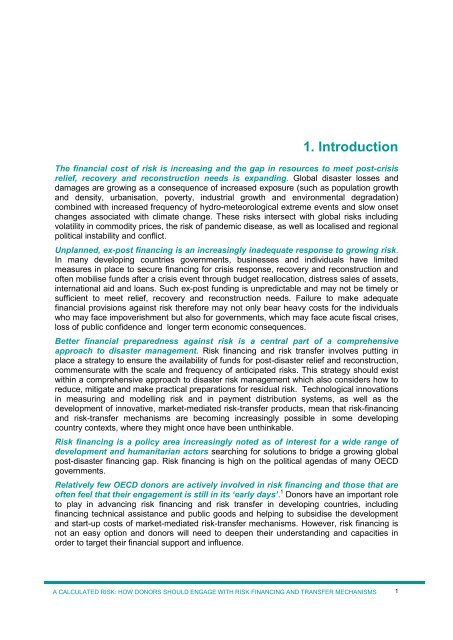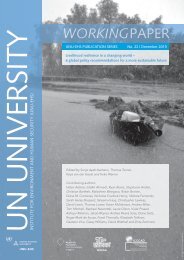k5q82a3
k5q82a3
k5q82a3
You also want an ePaper? Increase the reach of your titles
YUMPU automatically turns print PDFs into web optimized ePapers that Google loves.
1. Introduction<br />
The financial cost of risk is increasing and the gap in resources to meet post-crisis<br />
relief, recovery and reconstruction needs is expanding. Global disaster losses and<br />
damages are growing as a consequence of increased exposure (such as population growth<br />
and density, urbanisation, poverty, industrial growth and environmental degradation)<br />
combined with increased frequency of hydro-meteorological extreme events and slow onset<br />
changes associated with climate change. These risks intersect with global risks including<br />
volatility in commodity prices, the risk of pandemic disease, as well as localised and regional<br />
political instability and conflict.<br />
Unplanned, ex-post financing is an increasingly inadequate response to growing risk.<br />
In many developing countries governments, businesses and individuals have limited<br />
measures in place to secure financing for crisis response, recovery and reconstruction and<br />
often mobilise funds after a crisis event through budget reallocation, distress sales of assets,<br />
international aid and loans. Such ex-post funding is unpredictable and may not be timely or<br />
sufficient to meet relief, recovery and reconstruction needs. Failure to make adequate<br />
financial provisions against risk therefore may not only bear heavy costs for the individuals<br />
who may face impoverishment but also for governments, which may face acute fiscal crises,<br />
loss of public confidence and longer term economic consequences.<br />
Better financial preparedness against risk is a central part of a comprehensive<br />
approach to disaster management. Risk financing and risk transfer involves putting in<br />
place a strategy to ensure the availability of funds for post-disaster relief and reconstruction,<br />
commensurate with the scale and frequency of anticipated risks. This strategy should exist<br />
within a comprehensive approach to disaster risk management which also considers how to<br />
reduce, mitigate and make practical preparations for residual risk. Technological innovations<br />
in measuring and modelling risk and in payment distribution systems, as well as the<br />
development of innovative, market-mediated risk-transfer products, mean that risk-financing<br />
and risk-transfer mechanisms are becoming increasingly possible in some developing<br />
country contexts, where they might once have been unthinkable.<br />
Risk financing is a policy area increasingly noted as of interest for a wide range of<br />
development and humanitarian actors searching for solutions to bridge a growing global<br />
post-disaster financing gap. Risk financing is high on the political agendas of many OECD<br />
governments.<br />
Relatively few OECD donors are actively involved in risk financing and those that are<br />
often feel that their engagement is still in its ‘early days’. 1 Donors have an important role<br />
to play in advancing risk financing and risk transfer in developing countries, including<br />
financing technical assistance and public goods and helping to subsidise the development<br />
and start-up costs of market-mediated risk-transfer mechanisms. However, risk financing is<br />
not an easy option and donors will need to deepen their understanding and capacities in<br />
order to target their financial support and influence.<br />
A CALCULATED RISK: HOW DONORS SHOULD ENGAGE WITH RISK FINANCING AND TRANSFER MECHANISMS<br />
1



